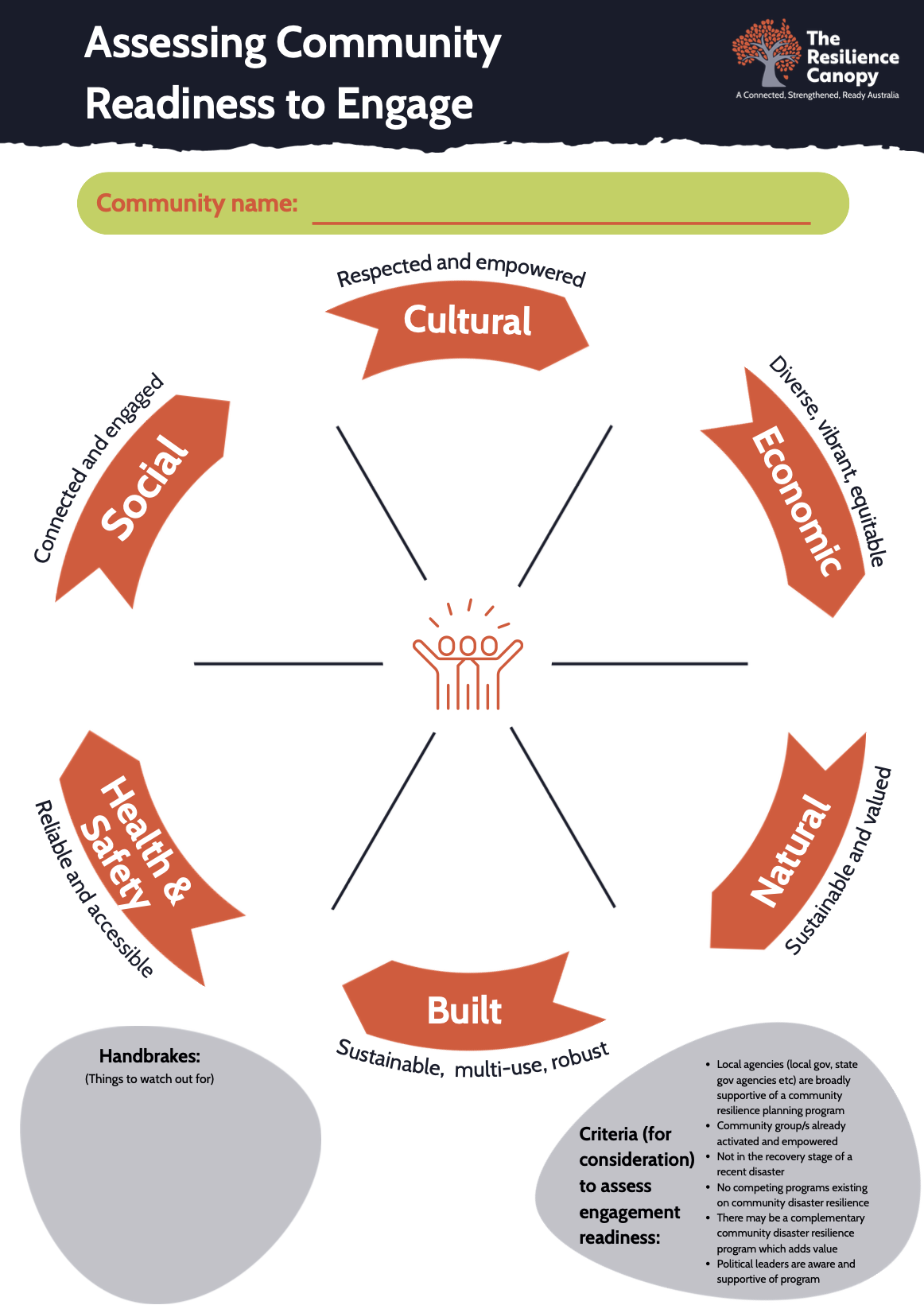Resilience Canopy Events are now live. Visit our Upcoming Events page
Resilience Canopy Practitioner Training
Resilience Canopy Practitioner Toolkit Templates
These are the templates that Resilience Practitioners can use when working through the 6-step process with community
Contents
Document
Link

Canopy Community poster (blank)
Canopy Community event poster with blank areas that can be used for filling in information about your particular event.
Pre-step: Assessing Community Readiness to Engage

Assessing Community Readiness to Engage
This activity aims to facilitate an exploration of your understanding of a community and enable an evaluation of its context and readiness to engage in the community-led resilience journey. This exercise should be undertaken when you are identifying a community to engage in community resilience planning, a critical step to feel confident that the community you are working with is ready.
.png)
Stakeholder Mapping Template
This stakeholder map is designed to help you identify who should be involved in early engagement (such as the inception meeting) and your commitment of engagement to them, it serves as a visual representation of the key stakeholders involved in your journey. Mapping your stakeholders is crucial for fostering collaboration and will lead to a more inclusive process, because you are actively considering the range of people/organisations that will be a part of this journey.
.png)
The Pitch Template
The ‘Pitch’ for the inception meeting is a key element in bringing community representatives together around a common purpose. This is designed to help you communicate in a clear and compelling manner what is being proposed, and why people should get involved. It helps provide clarity to the community and communicates the value proposition of working together. Ultimately, in the pitch, we want to share with the community what we are offering, what does the program deliver, how it will benefit them and what we see as their role.
Step 1: Foundations
.png)
Stakeholder Mapping Template
This stakeholder map is designed to help you identify who should be involved in early engagement (such as the inception meeting) and your commitment of engagement to them, it serves as a visual representation of the key stakeholders involved in your journey. Mapping your stakeholders is crucial for fostering collaboration and will lead to a more inclusive process, because you are actively considering the range of people/organisations that will be a part of this journey.
Step 2: Deep Dive

Strengths and Worries – Opportunities and Enablers Template
This activity is designed to assist you in facilitating a process with community representative to better understand their community’s strengths and worries with regards to resilience, both in the current state, and future. This is a grounding activity to reflect on the present while thinking to the future, what we would like to see, and what we would like to change. It provides a foundation for reflection and forward-thinking.
.png)
Community Connections Map
This Resilient Communities ‘Community Connections Map’ is designed to determine who needs to be involved in the next steps of the process. The purpose is to unpack who the community connections and networks are that can be called upon to support the community’s resilience building efforts.
.png)
Community Survey Template
This community survey is important to engage the broader community and gather the wider community’s thoughts about their greatest areas of need. After the community advisory group have built their shared knowledge and understanding about the resilience challenges and opportunities facing their community, it is important for the community group to think about what they would like to know from the broader community.

SWEAT Analysis Template
This activity is designed to assist you in facilitating a process with community representative to better understand their strengths and weaknesses plus threats and enablers with regards to their community’s resilience. This matrix can be a helpful tool if your purpose is to unpack strengths, weakness, enablers and threats in a way that supports community representatives to generate ideas for building resilience. If using this tool during this phase, try to focus on ideas rather than explicit solutions of actions.
Step 3: Field of Opportunities
.png)
Impact vs. Effort Matrix
This activity aims to create a prioritised and refined list of resilience building ideasutilising democratic processes that support the entire community’s resilience,reducing the situation where people may have a personal agenda.
Step 4: Partner
N/A
Step 5: Implement
.png)
Community Resilience Priorities Implementation Plan Template
Implementation planning for the focus areas/priorities within your Community Resilience Plan.
Step 6: Review
N/A








